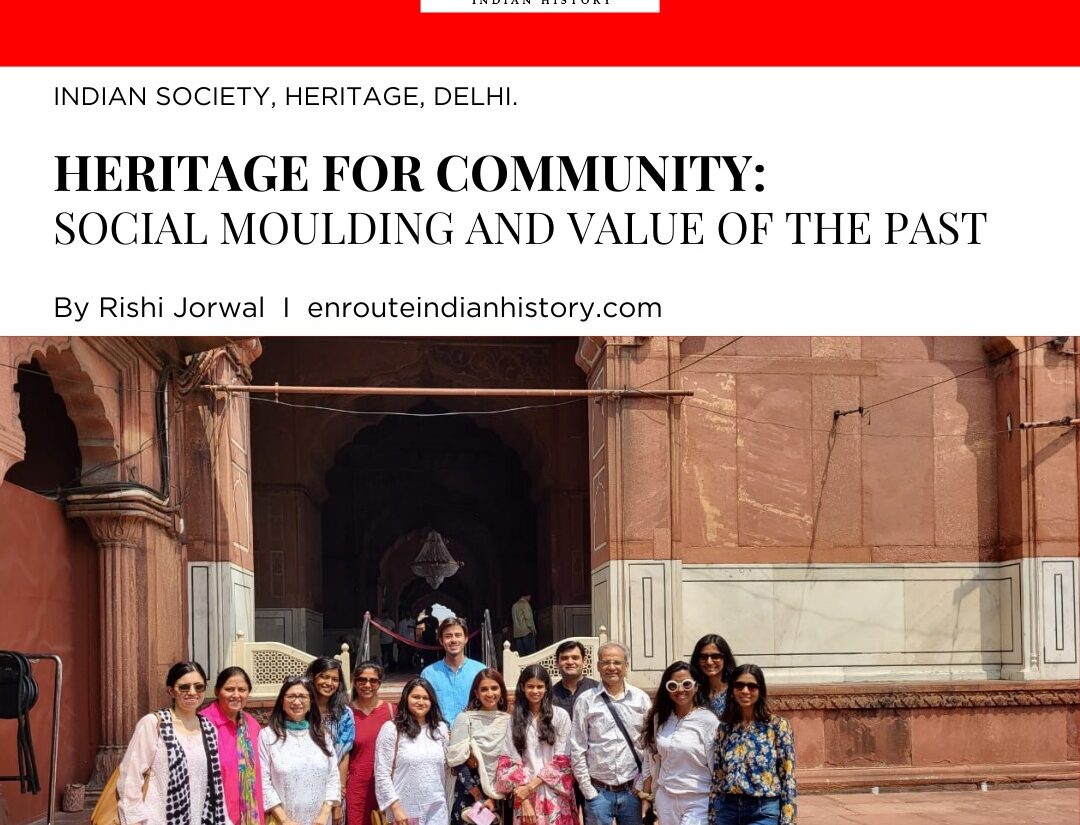Unveiling Delhi’s Historical Layers: Archaeological Excavations at Old Fort Delhi
- EIH User
- June 19, 2024

The Old Fort, or Purana Qila, is a monumental site in Delhi that has traditionally been linked to Indraprastha from the Mahabharata. The history of Old Fort Delhi reveals that it has been a site of continuous occupation through various historical periods, including the Mauryan and Mughal eras.

(IshiSenpai, Wikimedia Commons – A view of the Purana Qila)
Purana Qila, also known as Old Fort or Pandavon-ka-Qila, is historically significant and is identified with the ancient city of Indraprastha. The fort is situated on the western bank of the Yamuna River, which currently flows approximately 1 kilometer to the east. The site of Purana Qila encompasses an ancient mound that measures 710 meters from north-east and 350 meters from east-west, with an elevation of 11 meters above the surrounding landscape.
In 1533 CE, Humayun initiated the construction of Purana Qila as part of his new fortified city, Din Panah, meaning ‘Sanctuary of Faith’. By 1534 CE, the citadel’s walls, bastions, ramparts, and gates were nearing completion. Despite the existence of numerous forts in Delhi at that time, Humayun sought to commemorate his ascension by establishing a new citadel and city. The site was probably chosen due to its proximity to the revered Hazrat Nizamuddin Dargah. Humayun undertook this urban development project upon his return from Persia in 1555 CE, marking a significant period of his reign. After his return, Humayun resided at Dinpanah until his untimely death in 1556 CE.

(Manfred Sommar, Flickr – the front-view of the Qila-e-Kuhna mosque)
Sher Shah Suri took over and eventually completed the construction of the ramparts and other structures that characterize Purana Qila today during his reign (1538-1545 CE). These developments were built over the antiquated hill taking after the devastation and remodeling of Dinpanah. A prominent structure within Purana Qila is the Qila-e-Kuhna mosque, built by Sher Shah in 1542 CE. Located roughly opposite the Bada Darwaza, the mosque is approached from the back via a road leading east from the gate.
The Purana Qila has been a focal point while aiding in the archaeological discoveries in Delhi, with excavations uncovering artifacts dating back to the 3rd century BCE. The Purana Qila archaeological finds offer insights into the history of Old Fort Delhi.
The site where Purana Qila now stands has since antiquity been associated with the Mahabharata, precisely with the Pandava’s city of Indraprastha (the City of Lord Indra). This has led to the fort being known as the ‘Pandavon ka Qila.’ Further strengthening this are the textual sources like the Ain-i-Akbari by Abul Fazal which also mentions that Humayun built the fort at the site of Indraprastha, the ancient capital of the Pandavas. Up until 1913, there was a village named Inderpat within the fort’s walls, which was relocated when the British began constructing the modern capital of Delhi. Excavations at Old Fort Delhi have led to revelations that may or may not prove this but definitely point out the antiquity of this site and the various cultural levels associated with it.
In the 1954-55 Excavations at Old Fort Delhi undertaken by B.B. Lal with the aim of relating the site with Indraprastha, the primary investigations revealed the presence of Painted Grey Ware. It was also found in a village named Hastinapur in Uttar Pradesh, believed to be the Hastinapur from Mahabharata. The trial trenches in the lower levels of the mound had led to the discovery that the site had probably been under occupation since 1000 BCE.

(B.K. Thapar, Buried Past of Delhi; ASI – the stepped excavated area in 1969-70)
The excavations, however, were left incomplete and picked up later in the 1969-70 Excavations at Old Fort Delhi.Undertaken by B.B. Lal, B.K. Thapar and M.C. Joshi, excavations were resumed, and a 30-meter square area (about 50 meters south of the Sher Mandal or Humayun’s Library in the Purana Qila complex) was dug up. It was done in a stepped manner which allowed for the preservation of each succeeding period. This revealed remains of several successive existing on this site. The earliest to be found were at a depth of 9m from the surface and belonged to the Mauryan period (c. 3rd Century BCE). Some sherds of Painted Grey Ware were found on this level, implying that a settlement using these was probably situated nearby. It was from the Mauryan levels that the cultural and political sequence was found up until the early Mughal period.

(Indian Archaeology 2013-14 – A Review, ASI – the ring well of the Mauryan period)

(B.K. Thapar, Buried Past of Delhi; ASI – carved stone ring bearing probably a mother-goddess)
The Mauryan period was characterized by distinctively recognizable Northern Black Polished Ware (NBPW) – a dish fragment of which was found stamped with an elephant figure. Other Mauryan artifacts found were grey terracotta figurines of both humans and animals (like horses) and a carved stone ring bearing probably a mother-goddess. Evidence of drains built with wedge-shaped baked bricks has also been found indicating the urban development of the site. The Mauryan period is represented by a terracotta ring well with a diameter of 70 cm and a height of approximately 2.20 meters. A total of 18 rings have been exposed. Additionally, a drain running from west to east, encased with terracotta tiles on both sides, has also been unearthed from recent excavations at Old Fort Delhi in 2013-14.
The Sunga period (c. 2nd-1st Century BCE) revealed artifacts including more sophisticated pottery, terracotta plaques, and a variety of beads and ornaments. The pottery styles show increased diversity and certain changes in vase forms as found through a small, anthropomorphic vase. The terracotta plaques included depictions of demons and gods like mithuna, a standing female deity under foliage. The pottery from this period included red ware fragments such as collared rim basins, bowls with incurved rims, storage jars with thick rims, vases with grooved shoulders, and ink pot-type lids. Additionally, there are some pieces of grey ware and Black Slipped Ware from this period.

(Indian Archaeology 2013-14 – A Review, ASI – a house of the Kushana period)
The third cultural layer corresponds to the Saka-Kushana period, spanning from circa 1st century CE to the 3rd century CE. The pottery from this period includes red ware fragments such as sprinklers, ink pot-type lids, large to small bowls with incurved rims and carinated exteriors, and small to medium vases decorated with impressive stamped decorations of symbols. Additionally, copper coins of the Kushanas and Yaudheyas as well as distinctive terracotta figurines were also found. At this level, a notable discovery was of a house with three rooms – the walls of which were constructed with burnt bricks, while mud bricks were used for room partitions and flooring.

(B.K. Thapar, Buried Past of Delhi; ASI – gold-plated coin of the Gupta period)
During the Gupta period (c. 4th – 6th century CE), there were innovations in pottery with moulded and painted pottery being discovered. Inscribed terracotta sealings bearing the inscription “Brahma varta” in Brahmi script and Sanskrit language are particularly significant among the discoveries. A gold-cointed with an archer and Sri Vikrama was also found. During this period, Kushana bricks were repurposed for constructing new structures like houses of inferior quality. Additionally, brick-jelly floors, dating to the late Gupta period, were exposed at two locations. Underneath these brick-jelly floors, a wall developed from brickbats from an earlier stage was moreover found.
The Post-Gupta period (c. 7th-8th century CE) was essentially a continuation of the previous period, with no major development. The antiquities recovered from this period include terracotta dabbers, one inscribed in Brahmi script, female figurines, and semi-precious stone beads. The pottery during this period was red ware. A wall running in a north-south direction was uncovered, constructed from reused brick-bats with evidence suggesting that this wall may have been part of a potter’s house.

(B.K. Thapar, Buried Past of Delhi; ASI – the fortification wall of the Rajput period)
The Rajput Period (c. 9th-12th century CE) saw the appearance and discovery of pottery with new shapes, mainly of red and black wares decorated with painted or stamped designs. The main representative pottery of this period includes knife-edged bowls of various sizes with string-cut disc bases in red ware. This period is characterized by the discovery of a stone wall made of semi-dressed stones in square. The unusual width of the wall suggests it may have been a fortification, maybe of the Tomars.
The Delhi Sultanate Period (c. 13th – early 16th century CE) contained pottery characterized by Glazed Ware, which includes both brownish to white sandy friable and terracotta cores. These wares, made from medium to fine fabrics, are either plain or decorated with geometrical and floral designs. Bowls and dishes were found in abundance, and the ring base of the pots was a significant feature of this period. Traces of lime floors were unearthed, and beneath these, a stone rubble wall constructed with mud mortar running north-south from an earlier level was exposed. Coins belonging to Balban and Firoz Shah Tughlaq were also discovered.

(B.K. Thapar, Buried Past of Delhi; ASI – a Chinese porcelain with an inscription of a fairytale)
The artifacts found from the Early Mughal Period (c. 1530-56) have been discovered from a huge refuse pit. These include glazed ware and fragments of Chinese Celadon ware with one Chinese porcelain bowl bearing an inscription in Chinese which revealed its production in 1465-87 by the Ming dynasty during the Cheng Hua era. Other discoveries include terracotta animal and human figurines, a small stone image of Ganesha, glass wine bottles, and coins of Adil Shah Sur and Shah Alam. No structures from this period were uncovered during the excavation under review.
Purana Qila archaeological finds would aid in revealing the secrets that could unveil Delhi’s ancient and overlooked history. The excavation led by Archaeologist Vasant Swarnkar in 2017-18 did not reach the deepest layers. The Archaeological Survey of India (ASI) anticipates discovering additional Painted Grey Ware artifacts dating back to the period of the Mahabharata in the recent excavations that started in January 2023.
CITATIONS
- Singh, U. (2006). Delhi : ancient history. New Delhi: Social Science Press.
- Thapar, B.K. (1972). The buried past of Delhi. Expedition: The magazine of the University of Pennsylvania, 14(2), pp.21–26.
- Murari, K. (2023). Purana Qila is being dug up again. ASI wants to reach all the way to the Mahabharata era. [online] ThePrint.
- INDIAN CULTURE. (2024). Purana Qila: The Grand Old Fort of Delhi. [online]
- Purana Qila and its surroundings. (2012). Available at: https://www.wmf.org/sites/default/files/article/pdfs/Purana%20Qila%20and%20its%20Surroundings.pdf
- Tiwari, R. and Dimri, D.N. (2016). INDIAN ARCHAEOLOGY 2013-14 -A REVIEW. [online] Available at: https://asi.nic.in/admin/publications/ePublicationReportsDetails/download/15
- April 18, 2024
- 5 Min Read


















